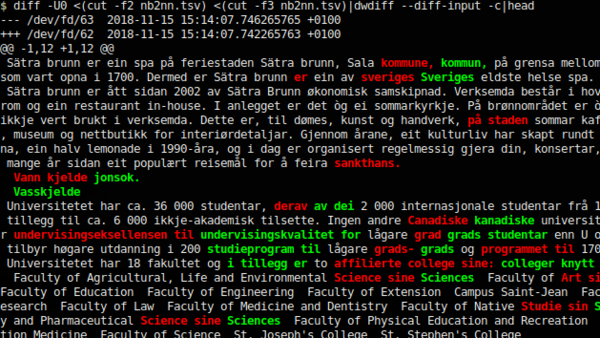Difference between revisions of "Wikipedia dumps"
m (add an internal link to Content Translation tool) |
|||
| Line 1: | Line 1: | ||
Wikipedia dumps are useful for quickly getting a corpus. They are also the best corpora for making your language pair are useful for Wikipedia's Content Translation tool :-) |
Wikipedia dumps are useful for quickly getting a corpus. They are also the best corpora for making your language pair are useful for Wikipedia's [[Content Translation]] tool :-) |
||
You download them from |
You download them from |
||
Latest revision as of 05:40, 10 April 2019
Wikipedia dumps are useful for quickly getting a corpus. They are also the best corpora for making your language pair are useful for Wikipedia's Content Translation tool :-)
You download them from
Tools to turn dumps into plaintext[edit]
There are several tools for turning dumps into useful plaintext, e.g.
- Wikipedia Extractor – a python script that tries to remove all formatting
- wikiextractor – another python script that removes all formatting (with different options), putting XML marks just to know when begins and ends everty single article
- mwdump-to-pandoc – shell wrapper around pandoc (see the usage.sh below the script for how to use)
- Calculating_coverage#More_involved_scripts – an ugly shell script that does the job
- wp2txt – some ruby thing (does this work?)
Content Translation dumps[edit]
There are also dumps of the articles translated with the Content Translation tool, which uses Apertium (and other MT engines) under the hood:
To turn a tmx into a SOURCE\tMT\tGOLD tab-separated text file, install xmlstarlet (sudo apt install xmlstarlet) and do:
$ zcat ~/Nedlastingar/cx-corpora.nb2nn.text.tmx.gz \
| xmlstarlet sel -t -m '//tu[tuv/prop/text()="mt"]' \
-c 'tuv[./prop/text()="source"]/seg/text()' -o $'\t' \
-c 'tuv[./prop/text()="mt"]/seg/text()' -o $'\t' \
-c 'tuv[./prop/text()="user"]/seg/text()' -n \
> nb2nn.tsv
Now view the word diff between MT and GOLD with:
$ diff -U0 <(cut -f2 nb2nn.tsv) <(cut -f3 nb2nn.tsv) | dwdiff --diff-input -c | less
and find the original if you need it in cut -f1 nb2nn.tsv.
For some languages, you have to get the _2CODE files or _2_ files, e.g. sv2da is in https://dumps.wikimedia.org/other/contenttranslation/20180810/cx-corpora._2da.text.tmx.gz and da2sv is in https://dumps.wikimedia.org/other/contenttranslation/20180810/cx-corpora._2_.text.tmx.gz – so let's filter it to the languages we want:
$ zcat ~/Nedlastingar/cx-corpora._2_.text.tmx.gz \
| xmlstarlet sel -t \
-m '//tu[@srclang="da" and tuv/prop/text()="mt" and tuv/@xml:lang="sv"]' \
-c 'tuv[./prop/text()="source"]/seg/text()' -o $'\t' \
-c 'tuv[./prop/text()="mt"]/seg/text()' -o $'\t' \
-c 'tuv[./prop/text()="user"]/seg/text()' -n \
> da2sv.tsv
